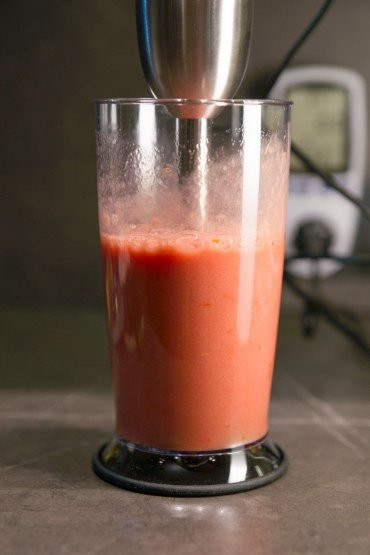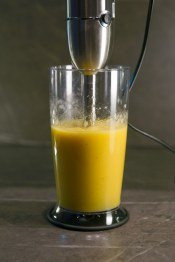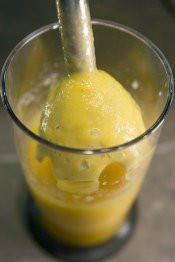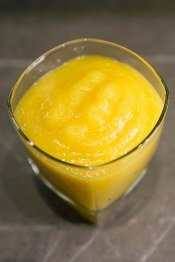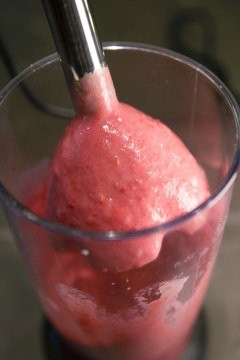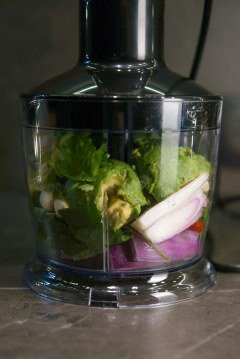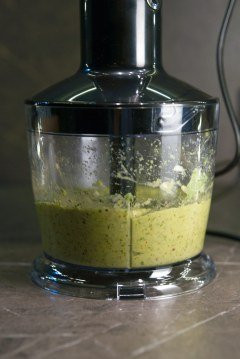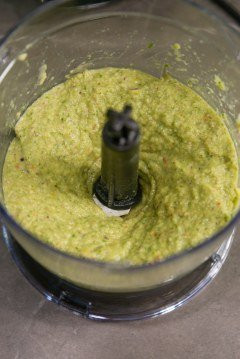The Polaris PHB 1637AL Cube is a versatile tool with a wide range of attachments and accessories designed for a variety of functions. This device provides the ability to grind, beat, mix, grate, shred, cut food into cubes and even bars.
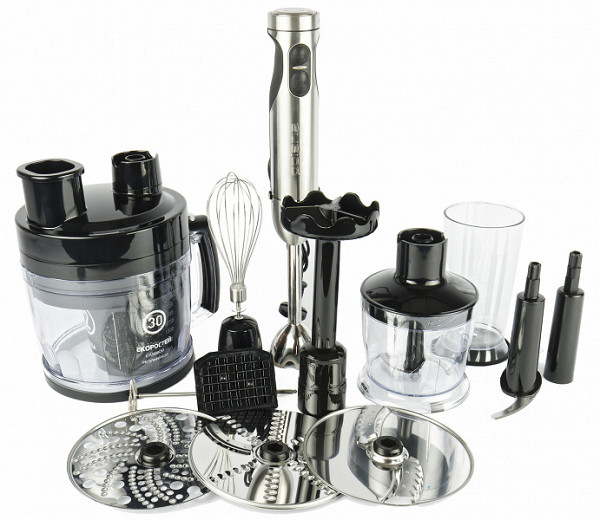
This device promises to significantly reduce the time spent in the kitchen and free up the owner's energy by eliminating boring and monotonous chores. It sounds attractive, as usual in advertising materials created by experienced marketers. Our goal is to find out how these promises reflect reality.
Characteristics
| Manufacturer | Polaris |
|---|---|
| Model | PHB 1637AL Cube |
| Type | immersion blender |
| Country of Origin | China |
| Guarantee | 24 months |
| Life time * | 3 years |
| Declared power | nominal — 1000 W, maximum — 1600 W |
| Control | mechanical |
| Indication | LCD display |
| Housing material | metal, plastic |
| Color | black, silver |
| Material of bowls and measuring cup | plastic |
| overheat protection | There is |
| Overload protection | There is |
| Protection against electric shock | class II |
| Smooth speed control | There is |
| Nozzles | immersion blender, whisk, cutting disc (slicing/shredding), hash brown grater, French fries grater, cappuccino maker, dicing attachment, puree attachment |
| Chopper bowl volume | 500 ml |
| Mixing glass volume | 600 ml |
| Combine bowl volume | 2000 ml |
| Net weight | 2.78 kg |
| Dimensions (W×H×D) | 66×407×66 mm |
| Network cable length | 1.2 m |
* Contrary to popular belief, this is not the time limit after which the device will necessarily break down. However, after this period, the manufacturer ceases to bear any responsibility for its performance and has the right to refuse to repair it, even for a fee.
Equipment
The blender arrived to us in a compact cardboard package made in the characteristic style of the Polaris brand. The packaging with a convenient carrying handle contains detailed information about the characteristics and features of the blender, and also provides information about the manufacturer and contains photographs of both the device itself and all included attachments.

Inside, the blender and attachments are tightly packed into the cutouts of cardboard inserts. All elements are placed in plastic bags, and some of them, additionally, in a small box.
Polaris PHB 1637AL Cube Kit:
- holder (motor unit)
- blender attachment
- whisk attachment
- cappuccino maker
- adapter for whisk and cappuccino maker
- attachment for making puree
- mixing glass (0.6 l) with lid
- chopper bowl (2 l) with lid and pusher
- two S-shaped knives (for large and small bowls)
- chopper bowl (0.5 l) with lid
- removable cutting blade axle
- three discs for potato pancakes, shredding/grating and slicing
- dicing attachment
- grate cleaning tool
- horizontal knife
- instruction manual and service book
At first sight
The Polaris PHB 1637AL Cube blender, which has many functions, is equipped with a variety of additional elements. We were convinced of the high quality of the materials of all attachments and their components, both visually and to the touch. All components look carefully thought out.
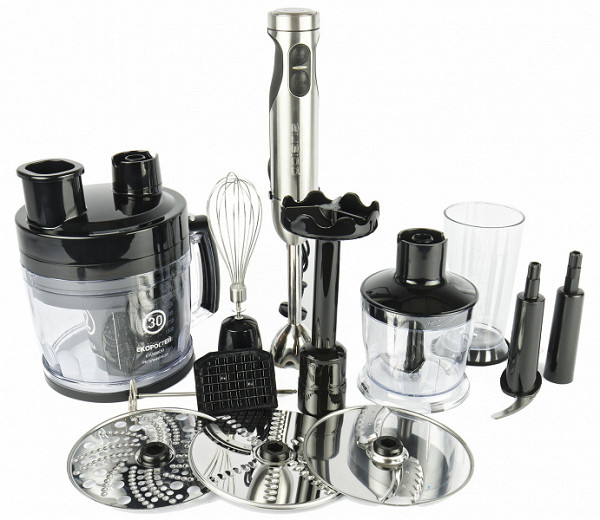
Let's start with the key element, without which no attachment can function — the motor unit. On the front side of the holder body there is a shiny metal plate, while on the back side there is matte plastic with a pleasant smoothness to the touch. The motor unit has a moderate but noticeable weight (700 g) and a comfortable narrowed grip area. This provides excellent hand feel, a secure hold and prevents accidental slipping.

The power supply comes out from the top of the case in the form of a cord 130 cm long. The junction of the cord with the holder is protected by a thick rubber casing. The control buttons on the front side are highlighted in black, and between them there is an operation indicator.
The speed controller, made in the form of a wheel with tactile movement, is traditionally located in the upper part of the structure.

The surface of the wheel is smooth, which, unfortunately, does not allow you to adjust the speed with one hand while holding the motor unit — there is not enough grip for your fingers. Information about the current speed is displayed on a small round display at the end of the holder.
The attachments are easily installed on the body in one motion with a click and can be easily removed by pressing two buttons on the sides of the holder. The unit is made of plastic. During removal and fixation, we did not detect any play or jamming.

Attachments that fit onto the motor block
The stainless steel blender attachment is a hemisphere with an uneven edge and five holes for better mixing of ingredients.
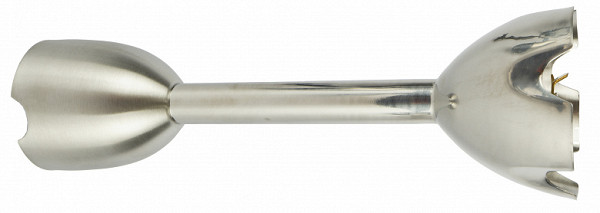
Inside the dome is a knife with four blades. The ends of the petals are curved: one pair is slightly upward, the other is downward.

For whipping, Polaris PHB 1637AL Cube uses a classic whisk shape. The nozzle is inserted into the adapter (some force is required for this), which, in turn, is firmly attached to the motor block.

The same adapter is also required for another attachment — a milk frother (cappuccino maker).

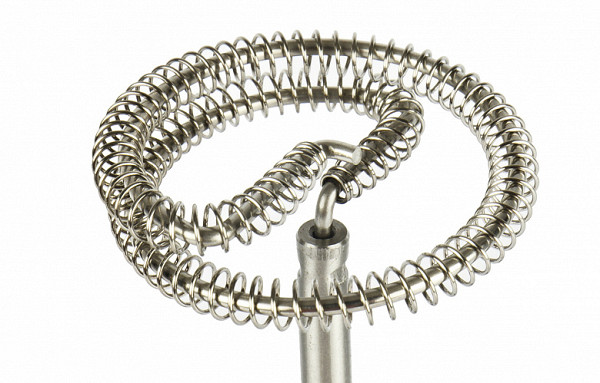
A clear plastic mixing glass is included. On the side wall of the container there is a measuring scale with marks marked from 100 to 600 ml with an interval of 50 ml. In addition to the glass, the set also includes a rubber lid. It can be used to store contents in the refrigerator or, when placed on the bottom, as an anti-slip pad.
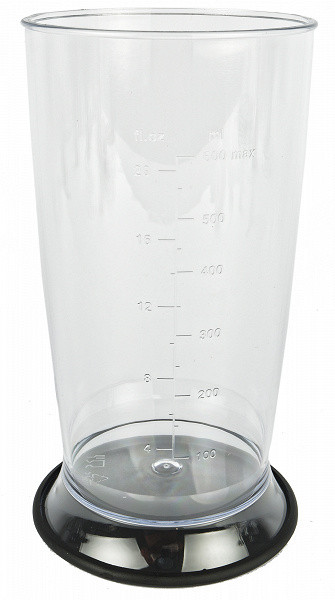
The puree attachment is made of durable black plastic. The dome of the nozzle with longitudinal and round holes has a wavy edge.
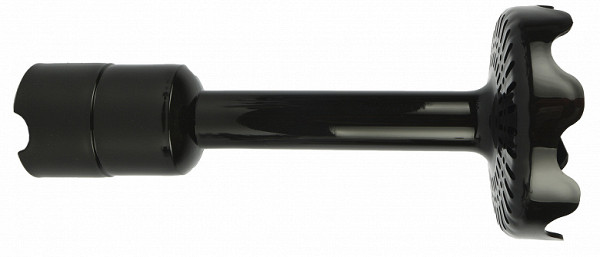

Inside the dome there are three plastic blades that actively rotate during operation, effectively mixing and chopping boiled vegetables or fruits. To facilitate the cleaning process, the rotating part of the nozzle can be easily unscrewed.
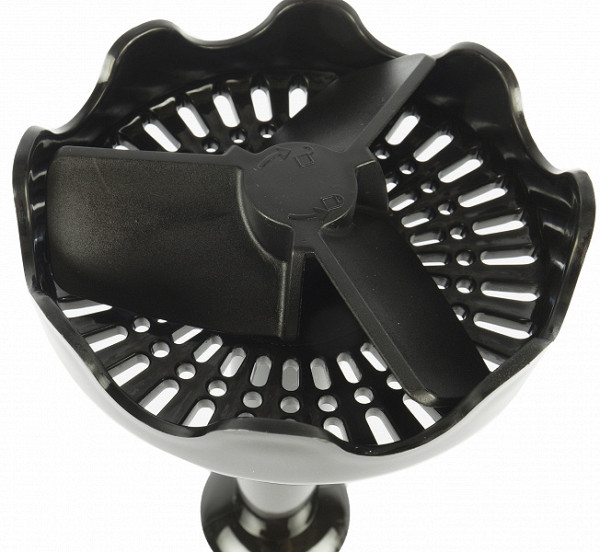
Bowls and attachments for them
The small 500 ml chopper bowl has a classic design with a capacity that becomes narrower towards the bottom and is marked with milliliters and ounces on both sides, and in the middle there is a pin for installing an s-shaped knife. The bowl cover has a protrusion for secure attachment to the motor block.
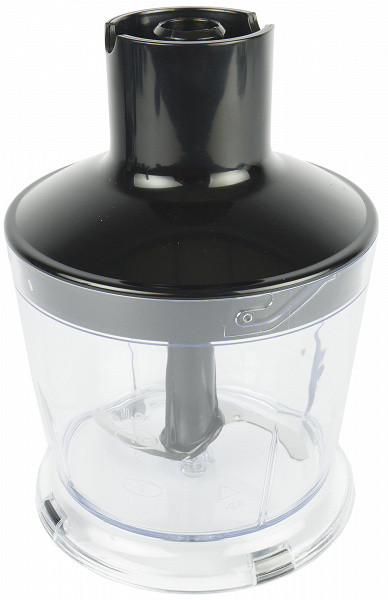
The large bowl is also made of transparent plastic. The base of the container is equipped with a rubber ring that improves grip on the table surface. There are two scales on the walls of the bowl: in ounces and milliliters (from 250 to 2000 ml).
The black lid has two protrusions: one is a rectangular pipe with rounded corners (for convenient feeding of products), the second is a socket for connecting the motor unit. A pusher is inserted into the product pipe, exactly repeating the shape of the hole. The internal size of the loading opening is 4.6x5.5 cm.
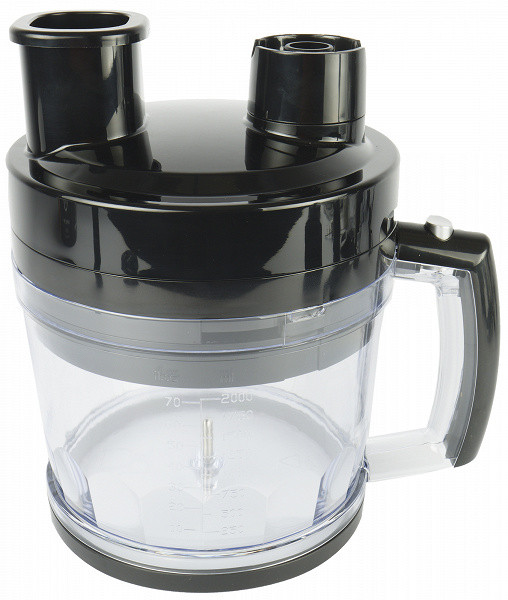
On the inside of the lid there is a gearbox, next to which there is a warning symbol prohibiting washing the part under running water.
The lid is equipped with a tongue and cutouts that must be aligned with the protrusions on the bowl, then turn the lid clockwise until the button clicks. To detach the cover, simply press and hold the button while simultaneously turning the cover in the opposite direction.

For chopping, a large S-shaped chopper knife is installed on the metal axis.

Stainless steel discs with cutting elements are designed for grating, shredding, slicing and preparing potato pancakes. They are mounted on a plastic sleeve, which in turn is mounted on the bowl pin.

The blades of the discs are highly sharpened, so you should be extremely careful when installing and cleaning accessories. Double-sided disc for grater and shredder.

In the photo from left to right there are discs for preparing potato pancakes, for grating/shredding and for cutting into bars
The dicing attachment is a massive plastic disc with a cutting grid and a rotating blade. During operation, the nozzle cuts the food into slices, which, under its own weight and/or using a pusher, pass through the grid knife and fall into the bowl in the form of cubes.
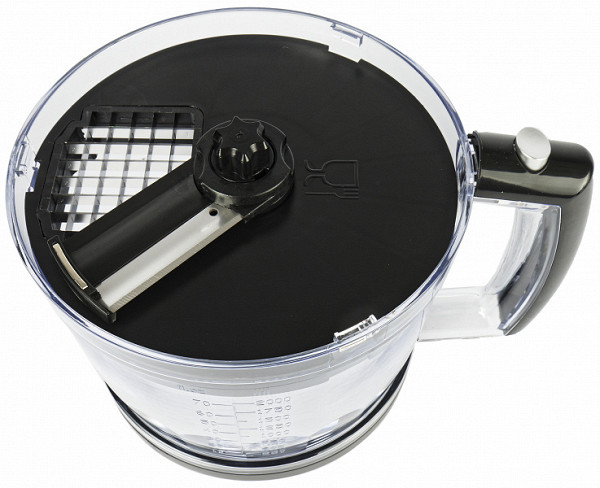
In order to push the remaining products out of the cells of the cutting grid at the end of the process, the kit includes a special plastic device.

Instructions
The instructions for the Polaris PHB 1637AL Cube are presented in the form of a 79-page brochure with high-quality color printing, made in the recognizable style of the brand. The text is presented in three languages: Russian, Ukrainian and Kazakh.
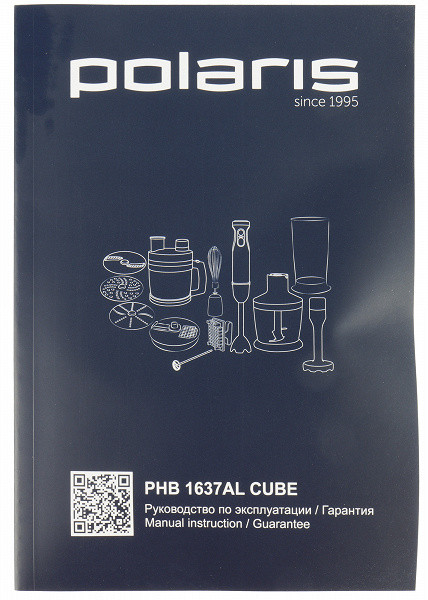
The instructions carefully cover all aspects of using each attachment, provide general safety recommendations, as well as instructions for care and cleaning of the device. Supporting illustrations accompany the text, making the information provided much easier to understand.
Control
The control panel consists of two buttons (main mode and turbo) and a blade rotation speed switch.
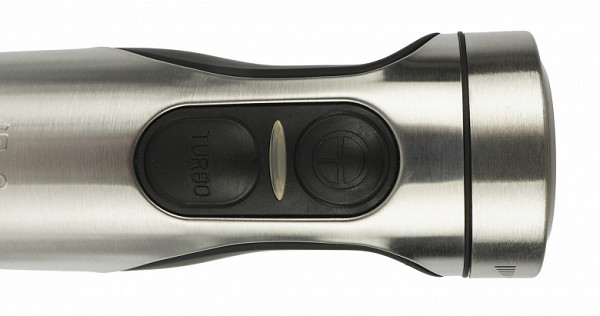
To activate the corresponding operating mode, you must hold the button. In the main mode, smooth speed control is provided by rotating the regulator wheel at the top of the motor block. When the blender is connected to the network, the operation indicator between the buttons is illuminated.
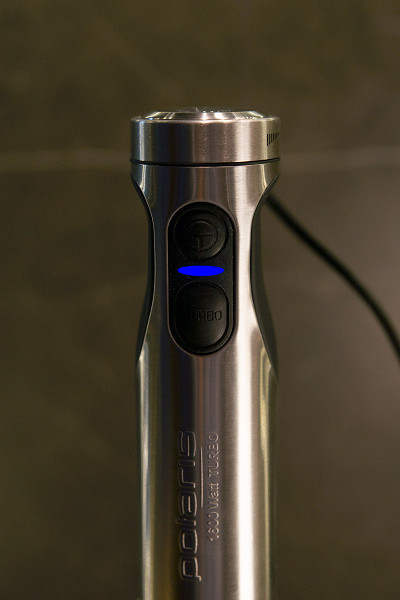
The digital indication of the current speed is displayed on the display when the main mode button is pressed.

The stroke of the regulator is discrete, and each turn is accompanied by a slight click. The display only shows numbers: 05, 10, 15, 20, 25 and 30, despite there being 30 possible speeds. Thus, despite the variety of speeds (30), the indicator displays only 6 values. For unification, we will use the numerical designations that are displayed on the display in the context of the speeds used in the tests.
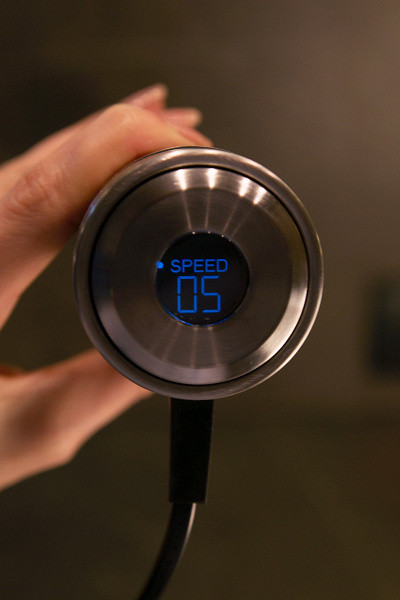
Between these digital values the regulator clicks 5-7 steps. Judging by the wattmeter, there is a difference in the power of intermediate values.
Exploitation
Before use, we thoroughly cleaned all removable components of the blender with warm water and a mild detergent. Those parts that should not be wet were wiped with a damp cloth. All elements were thoroughly dried before testing began.
Working with the Polaris PHB 1637AL Cube turned out to be easy and comfortable. The motor unit is comfortable to hold in your hand, and assembling and disassembling the attachments is not difficult. The only thing is that the whisk is somewhat more difficult to insert, but the elements are easy to control, and they do not work due to accidental touches.
The dome of the immersion blender is well designed, and during use we did not encounter any splashing or food particles getting stuck in the blade. After the first test, the mixing glass was naturally scratched — a typical situation for such devices, but this did not affect its functionality in any way. The plastic of both bowls remained in excellent condition after testing.

I was pleasantly surprised by the whisk, which usually does not attract serious attention in devices of this type. In this case, it not only prevents splashing, but also ensures high quality whipping of proteins. In the egg white whipping test, it took 6 minutes to achieve stable peaks without the motor overheating or hand fatigue, despite the weight of the holder.
We were also pleased with the efficiency of the cappuccino maker and the attachment for making purees. These are not simple attachments, as is often the case in multifunctional devices, but complete and effective components of the cooking process. They are comfortable and provide excellent results.
The large bowl with dicing attachment impressed us with its efficiency. Processing a kilogram of boiled vegetables took only 1-1.5 minutes — an ideal solution for preparing salads in large quantities. Slicing is not only fast, but also high-quality, with a minimum amount of waste.
The grater in this blender model also turned out to be effective, although the shredding results could have been better: small, torn cabbage leaves were common. The blender shredded 1 kg of cabbage in 50 seconds.
During the entire operation, the overheating protection worked only once, during the preparation of pate in a large bowl with a chopping knife. The blender stopped after 35 seconds in Turbo mode, but after a 30-minute rest it was ready to go again. There was no foreign smell or heating of the motor unit at this moment.
Blender blades and cutting disc blades are sharp, so care must be taken when using, cleaning and storing them. The noise level of the device when starting the engine from any of the attachments is moderate and does not cause discomfort.
Care
The motor unit, gear covers and whisk adapter should be cleaned by wiping them with a damp cloth as they cannot be washed under running water. All other parts of the blender can be cleaned under running water using a neutral detergent. In both cases, it is not recommended to use abrasive and chemically aggressive substances. Please avoid washing any parts of the device in the dishwasher.
Our measurements
The energy consumption of the device depends on the attachments used and the products processed. The maximum recorded power during testing reached 429 W when cooking pate in a large bowl using the chopper blade in Turbo mode.
The power when cutting food into cubes was 93 W, when chopping spinach with walnuts in a small bowl it reached 129 W, and during the operation of the grater attachment with raw carrots, the wattmeter showed a value of 109 W.
Practice tests
Grinding tomatoes (immersion blender)
As usual, testing began with a test on tomatoes. We were interested in the efficiency of grinding the skins and seeds, as well as the airiness and uniformity of the consistency of the resulting mass.
Place 350 grams of tomatoes, pre-cut into 4-6 parts, into a mixing glass and turn on the blender at minimum speed (05). After 10 seconds, the speed was switched to 15, and then to 20.
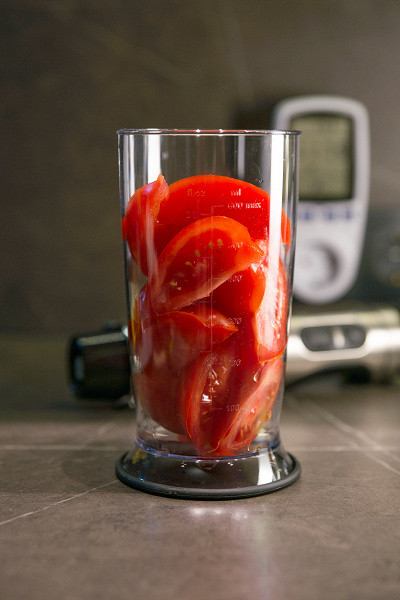
After 30 seconds, the tomatoes had become a fluffy mass, but bits of skins and seeds were still visible.
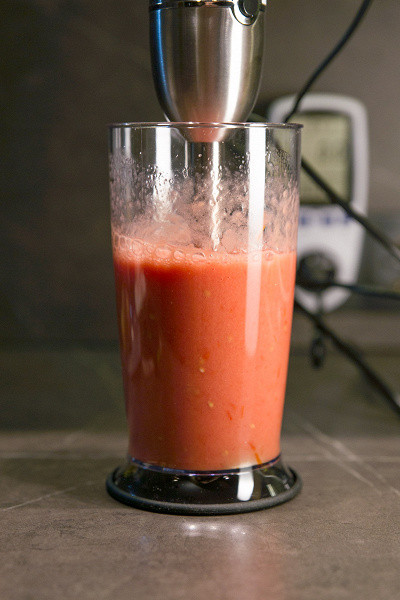
For the next 30 seconds the blender was activated in Turbo mode. The extra time and increased speed ground the skins and seeds more thoroughly, but did not completely remove the airiness from the finished mass.
During the entire time, nothing got stuck in the nozzle dome, and the contents of the glass did not splash out. We rate the grinding quality as good for an immersion blender of this type.

Result: good
Mango, Pineapple and Banana Smoothie (Immersion Blender)
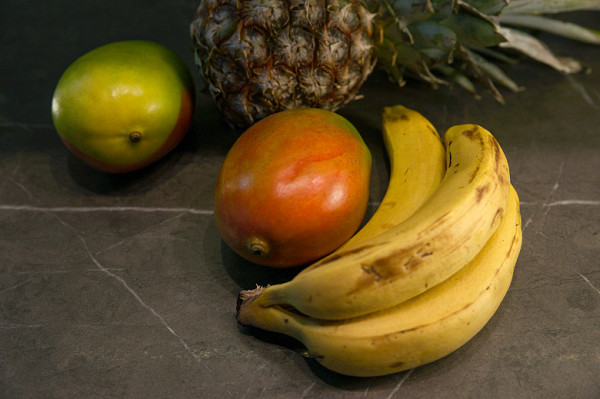
Next time, banana, pineapple and mango, pre-cut into large pieces, went into the glass. No liquid was added to the fruit.
We started with 5th speed, gradually added power, and towards the end of chopping we switched to Turbo. The blender worked for a total of 30 seconds. The smoothie is smooth, flavorful and absolutely delicious.
Result: excellent
Banana Smoothie with Frozen Raspberries (Immersion Blender)
In this test, we decided to check whether the Polaris PHB 1637AL Cube can handle the processing of heavily frozen berries. We added about 50ml of milk to a glass, placed banana slices at the bottom and added raspberries on top.
Grinding this set of ingredients took a little longer — 50 seconds. Starting at 15 speed, we switched to Turbo mode after half a minute.
The berries did not survive, the smoothie came out homogeneous and airy. We added it to chia seeds pre-soaked in milk and got a tasty and healthy snack.
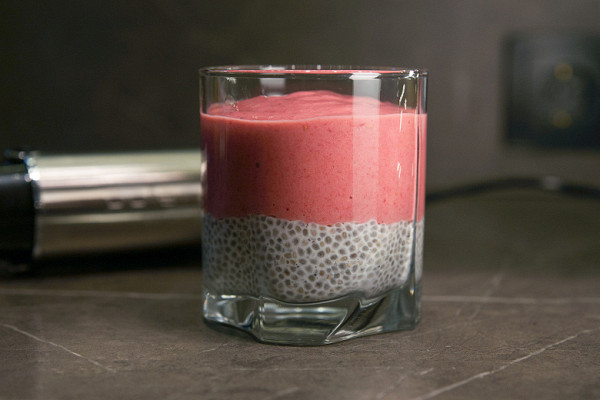
Result: excellent
Mashed potatoes (mashed potato attachment)
0.5 kg of boiled still hot potatoes with heated milk and butter became an airy and completely homogeneous puree in just 1 minute 40 seconds.
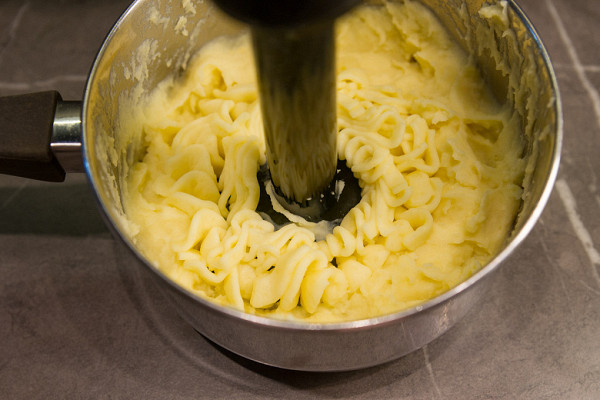
At first the blender worked at 5th speed, then we gradually increased it to 10th and then to 15th.
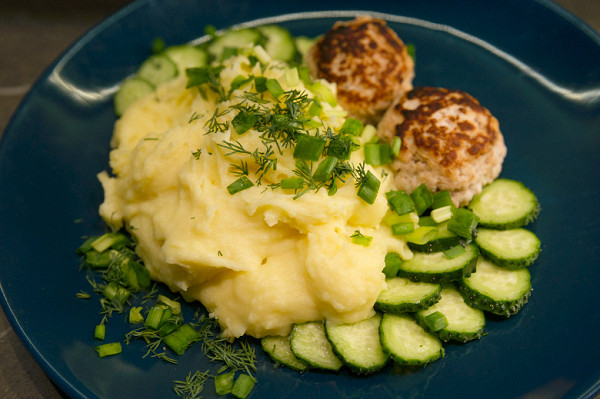
The consistency of the puree is excellent; there are a couple of small pieces of potato stuck in the nozzle itself, but there are no lumps in the mass.
Result: excellent
Beating egg whites (whisk)
The instructions recommend placing a maximum of 4 egg whites in a mixing glass and whisking them for no longer than 3 minutes continuously, after which a 5-minute break is required.

We started beating at speed 5 and gradually increased it to speed 30.

Third minute of beating
The foam increased in size and by the end of the 4th minute began to rise above the edges of the glass.
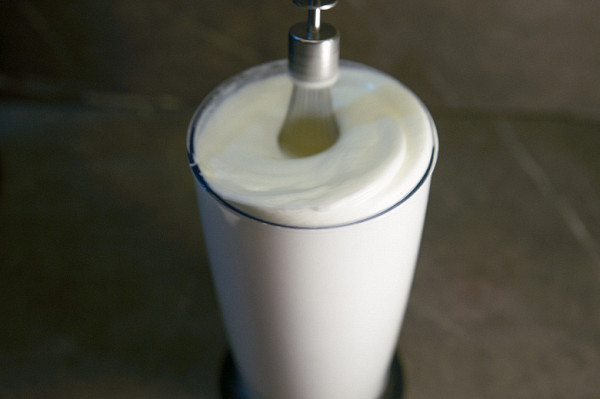
We transferred the air mass into a spacious bowl and continued whipping. Four whites weighing a total of 165 g were whipped in exactly 6 minutes. The blender seemed to cope with this task without any visible effort. No emergency shutdown occurred.
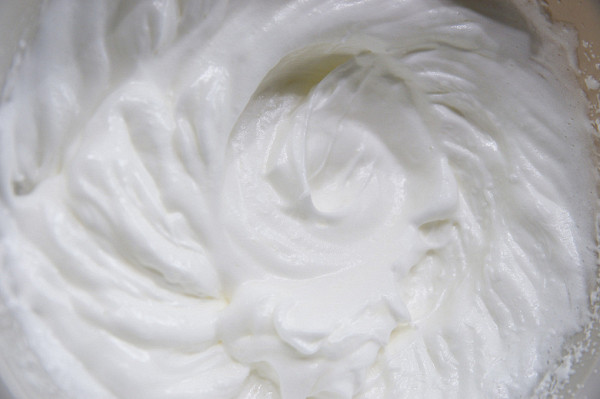
The whites were perfectly whipped into a thick, stable foam that did not fall out of the bowl when turned over.
Result: excellent
Milk foam (cappuccino maker)
For fluffy foam, we used heated milk with a fat content of 3.5%. It is more difficult to whip it up, but the taste of the foam is more intense.
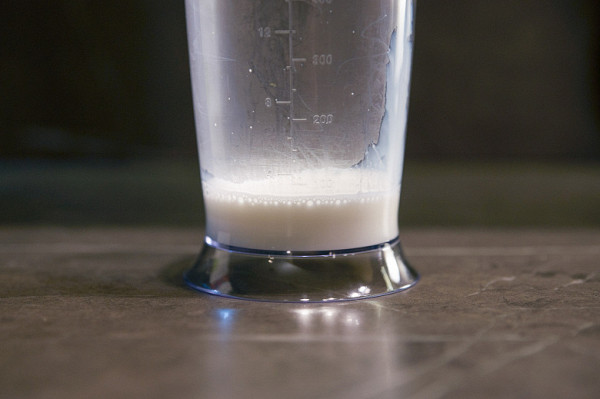
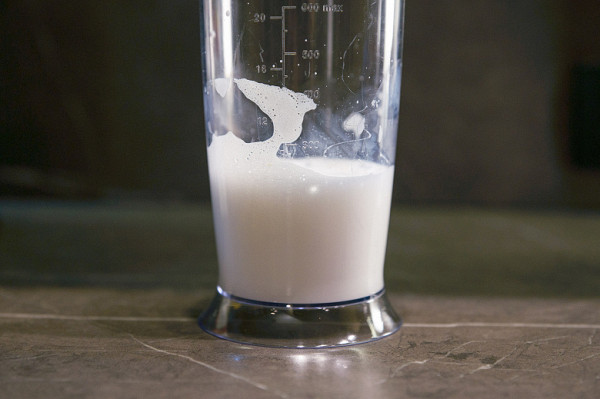
It took the cappuccino maker 2 minutes 40 seconds to whip, first at speed 15 and then in Turbo mode.
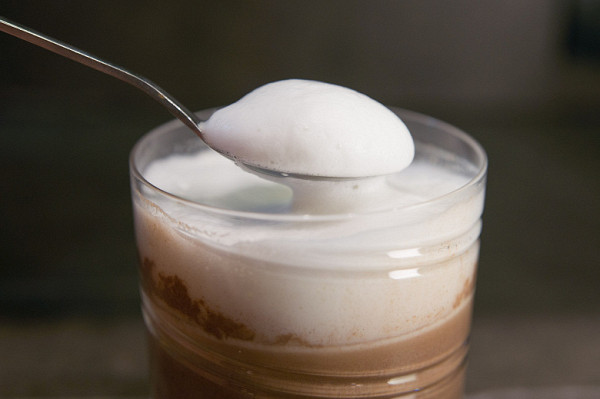
Result: excellent
Carrots (grater)
As it turned out in practice, 0.5 kg of raw large carrots were easily ground into neat, uniform chips in exactly a minute.
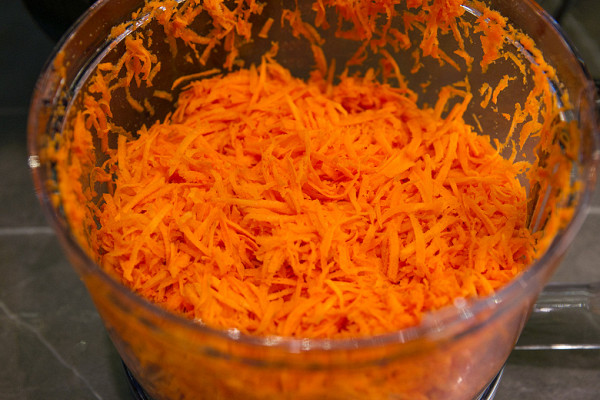
We tested the cutting disc with a grater at 15th speed. There was practically no need to use the pusher. As we see, there is little waste. Nothing got stuck in the process.
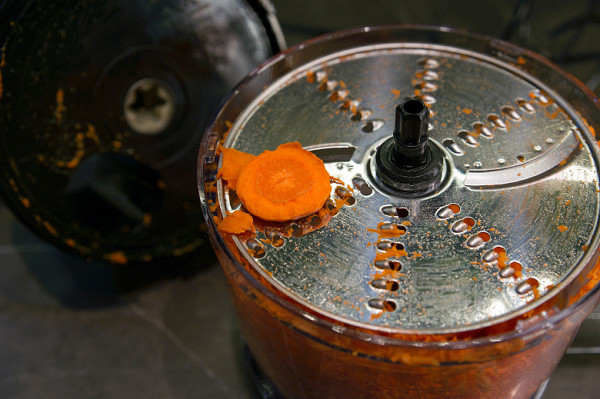
Result: excellent
Carrots (shredded)
Turning the disk with the shredder blades upside down, we took the remaining couple of carrots and lowered them one by one into the neck of the lid. The whole process happened as quickly as in the previous test. At the bottom of the bowl we found carrots cut into thin slices, and only a few pieces of the vegetable were stuck in the disk itself.
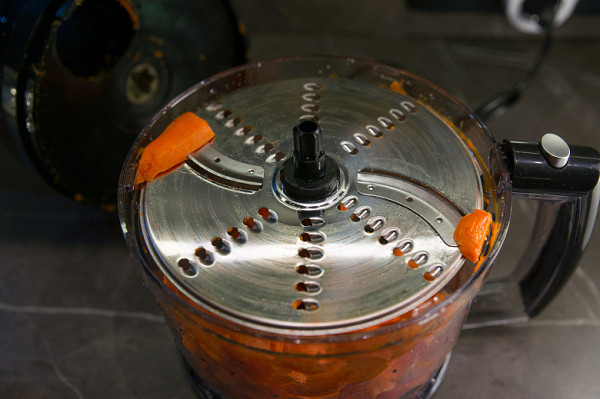
True, not all the plates were round; a small part was still cut diagonally.
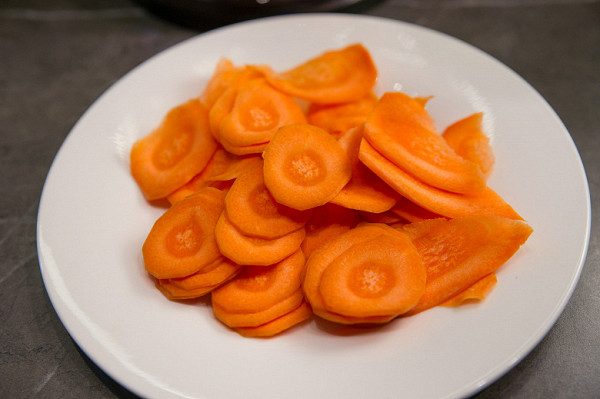
Result: excellent
Cabbage (shredded)
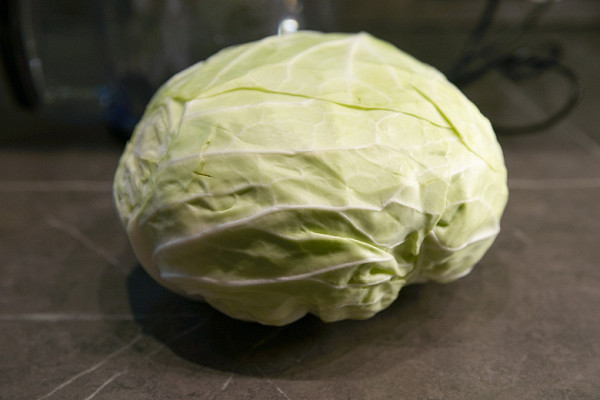
0.5 kg of cabbage at 15th speed was shredded in 23 seconds, not counting the time we spent feeding the vegetable into the neck of the device — only the pure operating time of the motor.
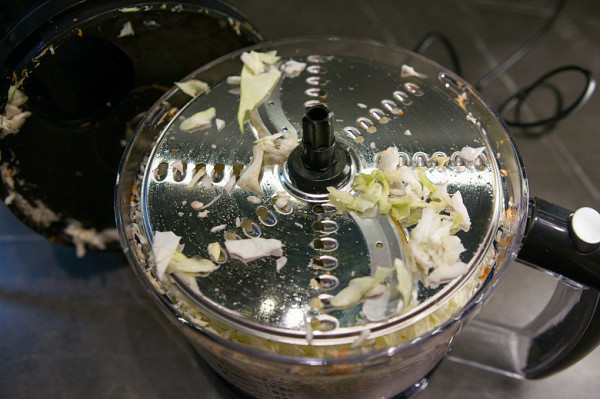
Overall, very good, but this is not the most ideal result — the resulting cabbage contained small fragments of torn leaves.
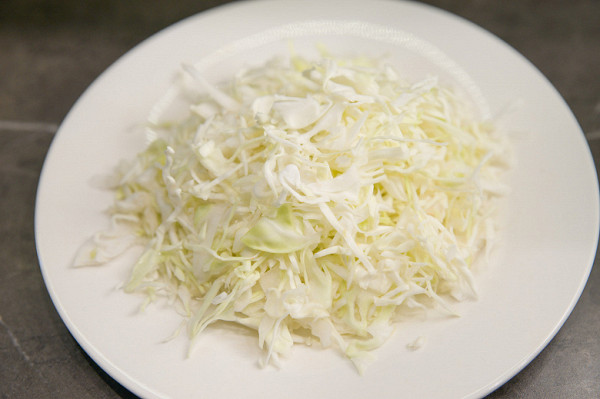
Result: good
Potatoes and carrots (cut into cubes)
The cutting disc for cutting into cubes also works quickly. Just when using it, do not forget about the pusher. Without pressing on the vegetable from above, we risk getting this result.
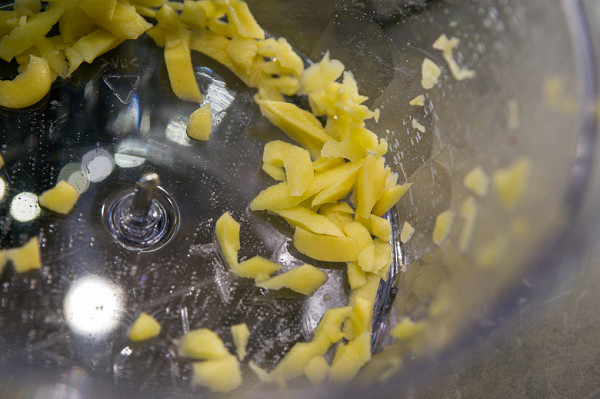
The harder you press, the longer the bars come out.
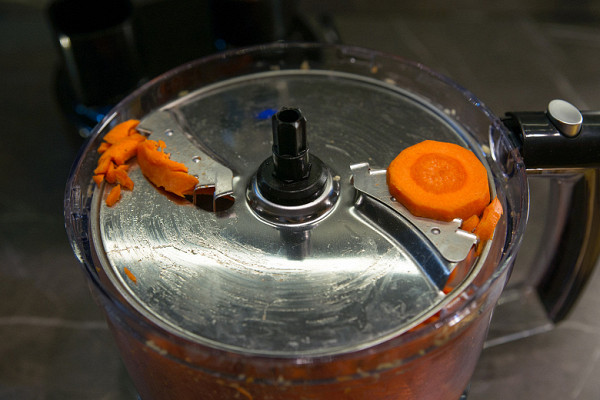

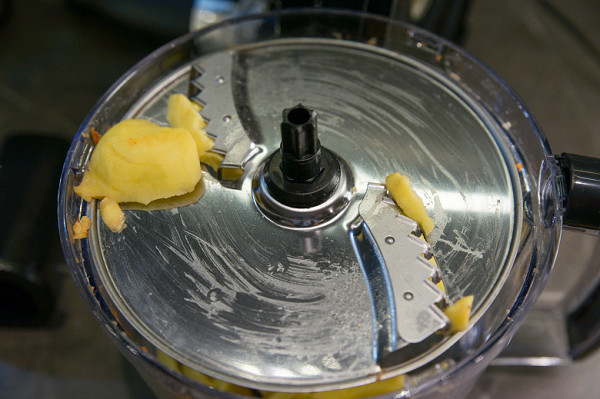
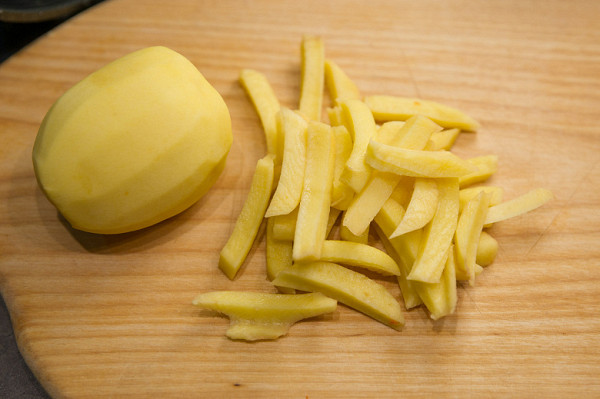
Result: excellent
Boiled vegetables (cut into cubes)
Boiled vegetables (cutting into cubes) Cutting boiled vegetables into cubes, if you do it yourself, is long, tedious and not always equally smooth. With Polaris PHB 1637AL Cube everything happens much faster.
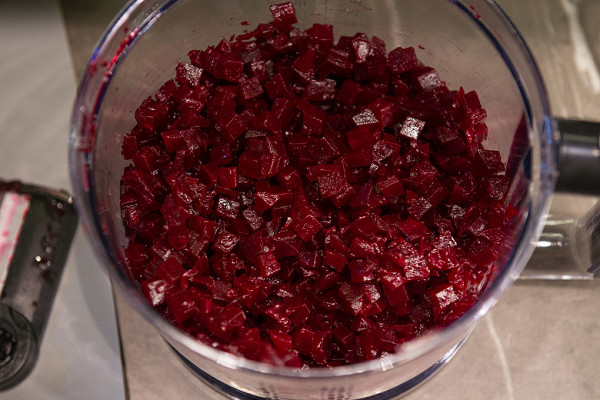
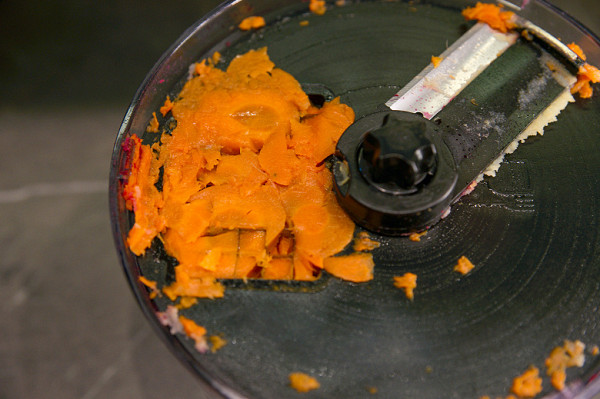
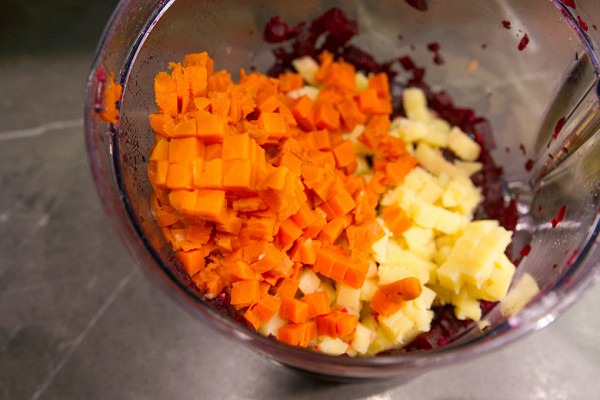
The cubes turned out smooth, and the amount of waste was minimal. We cut at different speeds, and the results were equally excellent. From our subjective point of view, 10th speed is optimal. In this case, the pusher was not needed at all. 3 kg of vegetables were processed in 4 minutes, and during this time the bowl was filled to the brim twice.
Result: excellent
Phali (small bowl)
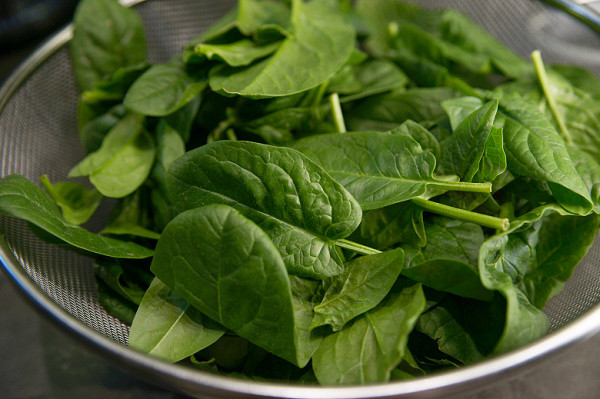
A pre-washed and dried bunch of fresh spinach weighing approximately 180 g was immersed in boiling salted water. The greens were kept in water for about 30 seconds, then carefully placed in a colander, rinsed with ice water and squeezed out of excess liquid.
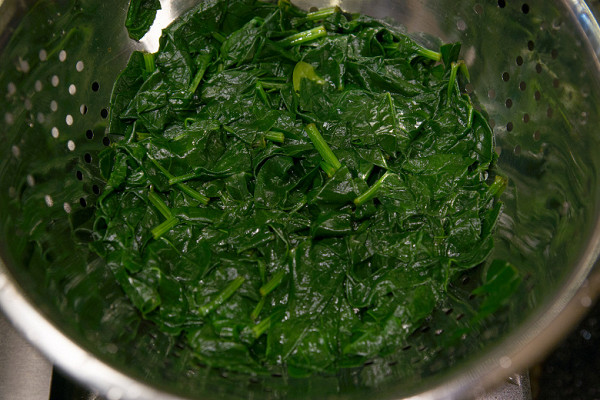
Place spinach in a small bowl, top with a bunch of cilantro, about 80 g of walnuts, a couple of cloves of garlic, sprinkle with salt, add suneli hops and half a tablespoon of vegetable oil.
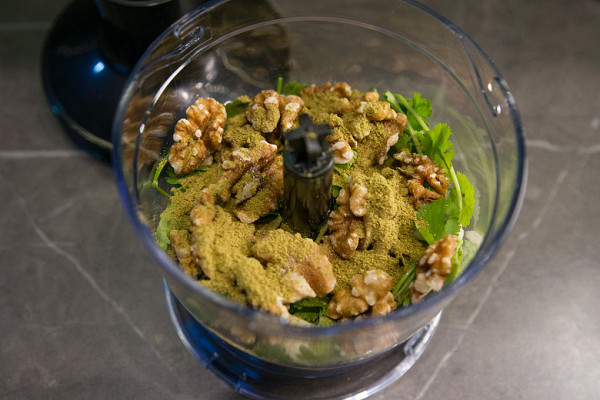
The grinding took place first at 10th speed, then at 15th, and at the end, to be sure, they turned on the Turbo mode. The process took exactly a minute.
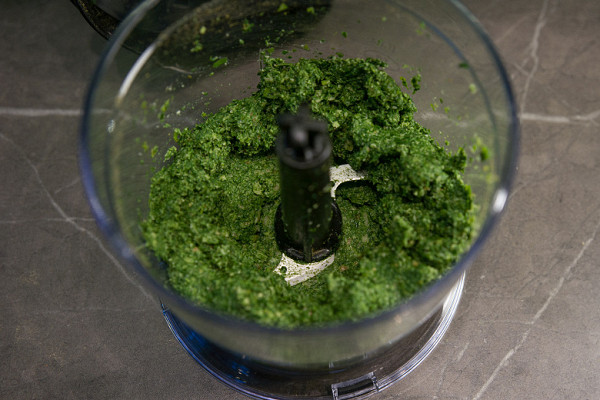
The mass turned out to be homogeneous; we did not find a single stalk, a whole piece of garlic or nuts.

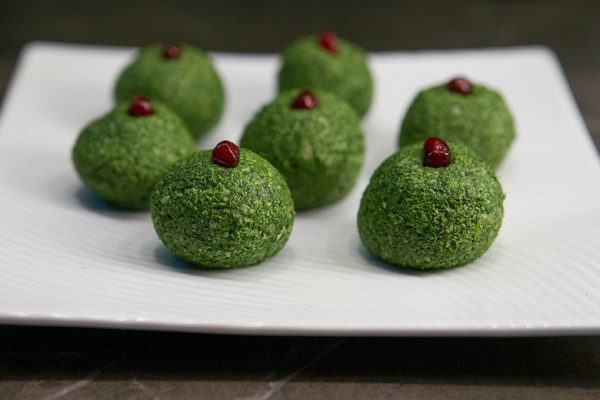
Result: excellent
Guacamole (small bowl)
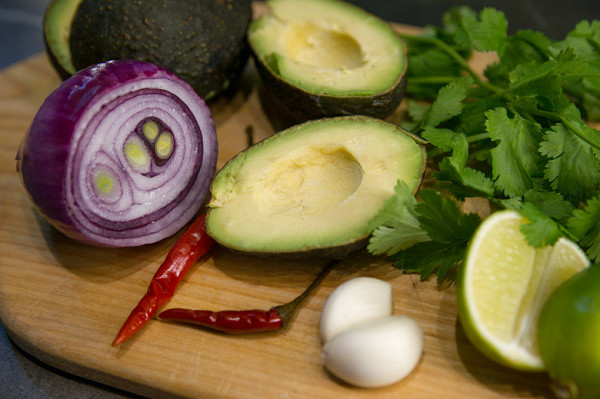
For a spicy appetizer, we took a couple of avocados, half a red onion, a bunch of cilantro, two small chili peppers, put all the ingredients in a bowl, squeezed the juice of a whole lime on top and sprinkled with salt.
Grinding took only 35 seconds. Half the time the blender worked at 10 speed, then in Turbo mode.
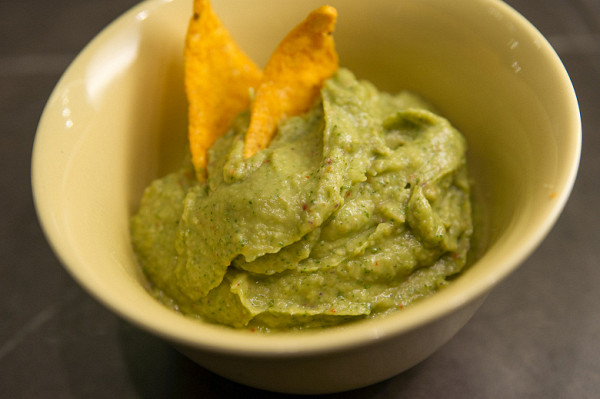
Result: excellent
Pate (large bowl)
We completed our testing with an advanced test. Although the instructions do not recommend putting more than 800g into the bowl, the total weight of our ingredients was 1.3kg. Instead of dividing them in two, we decided to take a chance and use a large bowl with a chopper blade.
We placed boiled carrots, boiled chicken breast, fried and then stewed chicken liver with onions in a bowl, and also added butter. Season the top with salt, a pinch of nutmeg, and to prevent the pate from becoming too dry, add 200 ml of chicken broth.
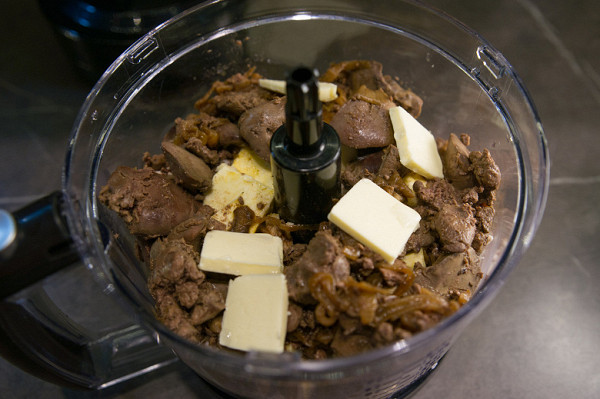
When turned on, it became clear that at speeds 5 and 10 the blender could not cope with the thick mass. Then we switched to 20th, and after 1.5 minutes — to 30th. After another 2 minutes, the contents of the bowl began to resemble pate, but large pieces of chicken and carrots were still present. We decided to use turbo mode.
After 35 seconds of continuous operation, the blender stopped. At all. It did not respond to button presses, and it became obvious that the overheating protection had tripped. Then, following the advice from the instructions, we disconnected the device from the power supply and let it rest for half an hour.
After 30 minutes, the blender started working again, we ran the pâté in turbo mode again, but this time we limited it to 20 seconds. This manipulation was enough to obtain the desired consistency and finally get rid of whole pieces from the total mass.

Result: excellent (with reservations)
conclusions
The Polaris PHB 1637AL Cube blender successfully passed our tests and pleased us with excellent performance results. All attachments perform their stated functions perfectly. The ergonomics of the device are well thought out, assembly of all components takes only a few seconds, the materials (with the exception of the plastic of the mixing glass) can be considered high quality, and the controls are convenient.
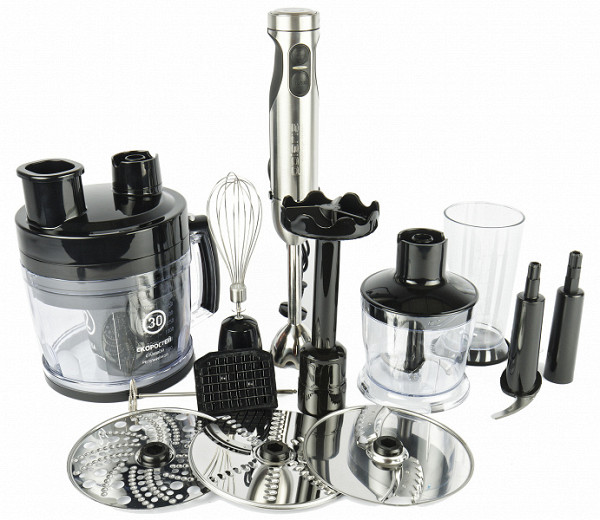
After using this device, we were left with extremely positive impressions. This blender can most likely even be called a food processor, since it can replace several devices and significantly reduce the processing time for large volumes of products.
We did not identify any negative aspects in the work. Perhaps one could find fault with the quality of the cabbage shredding, but a small number of torn leaves against the background of all the other excellent results can be considered rather minor remarks. It is also worth noting that the plastic of the mixing glass quickly loses its original appearance, but, unfortunately, this is a fairly common phenomenon with blenders of this type.
Pros:
- elementary controls and ease of use
- a large number of attachments and accessories
- excellent test results
- quickly and accurately chops large volumes of food
- moderate operating noise
Minuses:
- The plastic of the mixing glass gets scratched quickly from the inside

